
24 minute read
ARTICLES
A NATIVE PLANT TASK FORCE
Gardening as though our lives depend on it
Advertisement
BY SALLY CUNNINGHAM
Goldenrod (solidago) is a great late-blooming native with many manageable varieties.
The Western New York Native Plants Collaborative brings together government entities, educational institutions, nonprofit organizations, and the green industry around the same goal: healing the Western New York ecosystem.
Co-founded by two longtime leaders of the local environmental/conservation movement, landscape architect Linda Schneekloth and native plant expert/ working with a diverse group of other projects for Applied Ecological educator Ken Parker, the NPC has the environmental advocates, who also Services. He comments, “One of following goals: have well-defined views on what the most disturbing tendencies I • Restoration of the unique the local ecological landscape is see is the homogenization of the ecology of natural areas, the value and what it should be. For example, urban environment, manifested of each place recognized not only Paul Fuhrmann, a habitat restoration today as the landscape aesthetic for the pollinators and songbirds, specialist long associated with of manicured lawns and pristine but for its uniqueness. Ecology and Environment Inc., has perennials that are typically • A new definition of what front provided leadership across many undisturbed by wildlife of any kind and back yard landscapes can be, to organizations and projects. He cites (meaning that they are not involved include less lawn (with ecologically positive examples of urban habitat in the life cycle of any organism, and sound management where lawn restoration using native plants in contribute nothing to the ecological is desired), layered plantings, Tifft Nature Preserve, Forest Lawn function of the landscape). Native hedgerows with native plants Cemetery, Times Beach, Seneca plants are considered undesirable between properties, and pollinator Bluffs, and parts of the Outer Harbor, weeds and are removed in favor of plants and edible landscapes in but adds that there’s a long way to 'exotic' plants that are to be found front of homes. go to restore damage and recoup in the garden of any house of a • Public understanding that the losses: “This is where municipalities similar climate, worldwide. current status quo is unsustainable, and private landowners can make a Naturalist and Spree columnist including the sprawl of sterile, difference. There is no land area too Gerry Rising regrets that movement ecologically valueless housing small to have positive ecological toward action on behalf of habitat developments and the degradation impacts. Backyards, lawn aprons has been so slow in coming: of wetlands. along roadways, vacant lots can all “Until recently only professional support native plants.” botanists—and in fact not many Expert voices for change Another NPC member, Joshua of them—have understood the
Schneekloth and Parker are Konovitz works on restoration important role that native plants
play in support of our environment. And it’s not just plants that are native to our region, but also plants that are native to specific local environmental niches. While a native tree hosts a wide range of fauna and flora, an introduced species often stands starkly alone. That may seem at first attractive to farmers and gardeners—‘none of them damned bugs!’—but most of those insects support such necessary activities as pollination. And the insects require the native plants, the plants with which they’ve co-evolved.”
How to get there
Parker was formerly the largest native plants grower in Canada. He stresses the crucial need for plants with local provenance, for many reasons. As he explains, some pollinator or bird depends upon a flower, fruit, or seed at a very specific time. But the native shrub cultivar (often called nativar) or the same shrub species that was grown in Ohio may produce a flower that opens too early or too late to do its job. Or the “improved” flower or fruit is too big or too closed or the wrong color to serve its natural purposes. Provenance counts.
Restoration projects in the region, such as the Niagara Gorge Findlay site, a WNY Land Conservancy project, already have nurseries producing plants to order. For Findlay, a couple of nearby nurseries are producing 15,000 plugs of forty-three locally collected North American native species. Other growers are producing seed from six locally collected native species. But it’s not enough. More growers are needed for more restoration projects, and more growers and individuals will be needed to grow native plant species—especially as the customers request those. Rising observes that until recently it was difficult for anybody seeking native plants to find them: “Helping garden suppliers to identify, advertise, and sell those plants to their customers is, I think, one of the most important goals of the Native Plants Collaborative.” FY
If all mankind were to disappear, the world would regenerate back to the rich state of equilibrium that existed ten thousand years ago. If insects were to vanish, the environment would collapse into chaos. —E. O. Wilson
Sally Cunningham is a Certified Nursery & Landscape Professional and author of Buffalo Style Gardens.
AN AUTUMN HIKE— THE NATIVE PLANTS YOU’LL SEE
Looking forward to fall, native plant geeks pick their favorite fall hikes:
Gerry Rising: “My favorite fall plants are arguably the most common: asters and goldenrods. While others are looking up at the electrifying maples, I am more attracted to the shades of gold and blue or purple that adorn our fields, often together. That these simple ‘weeds’ should provide so much beauty I find deeply satisfying.”
Lyn Chimera grows and shows visitors hundreds of native plants during Open Gardens every July. Among less widely known plants she notes, “Look for the White Snakeroot (Eupatorium rugosum). It is typically at the edge of a woods, in masses.”
Ken Parker reminds hikers to look at the berrying shrubs and up to the trees: Serviceberry leaves have turned shades of yellow and orange. Wild grapevines and red-leaved Virginia Creepers are climbing high. Staghorn and Fragrant Sumacs are offering bright and nutritious scarlet drupes.



My own favorite native perennial is New York Ironweed (Vernonia noveboracensis), in part because I have encouraged many clumps to spread from one plant (now eight feet tall) that I bought twenty years ago.
Take a walk. Try to identify native from nonnative plants and notice what the birds and insects are using.
NATURAL STRATEGIES FOR PAIN RELIEF
BY CATHERINE STACK
Turmeric root is celebrated for its anti-inflammatory properties.

How many people do you know who are taking ibuprofen (Motrin, Advil, etc.) on a regular basis? Although this is one of the best over-the-counter pain relievers, regular use will ultimately result in stomach issues such as ulcers and erosions. Even worse are the prescribed narcotics that over time trick you into thinking you still need them and constipating the bejesus out of you—which, in itself, is horribly painful.
Addiction issues are more prevalent doesn’t have harmful or addicting For the constipated individual, take than anyone thinks. This is a sad state side effects, listen up. These are more than the recommended dose, of affairs in our society. some of the best remedies for and citrate works best. The worst that
For those of you who suffer from chronic aches and pains. will happen is a healthy poop. Most joint pain, fibromyalgia, back pain, people feel great after they empty their and bulging discs, we must look Diet colon. Magnesium glycinate works at what is going into that mouth of I always start here, because you best for back pain, muscle pain, and yours. Sugar and foods that easily cannot out-supplement the foods Restless Leg Syndrome. convert to sugar (high-glycemic) you put in your mouth. My favorite cause inflammation. Foods that anti-inflammatory foods include wild Bromelain aggravate inflammatory conditions blueberries, asparagus, spinach, Bromelain’s anti-inflammatory include gluten, grains, corn, soy, cilantro (heavy metal detox), avocado, properties make it a great dairy, eggs, artificial flavors and coconut oil, garlic, ginger, leafy greens, natural replacement for harmful sweeteners. INFLAMMATION=PAIN. lemons and limes, fennel, celery, flax medications like aspirin. Recently,
So, for ninety percent of us, food seed, walnuts, and pineapple. This is the Journal of Alternative Therapies is the cause as well as the remedy. just a very condensed list. in Health and Medicine published a Sugar is as addicting as heroin. We research trial that evaluated fortycrave it, we ache for it, and, ultimately, Magnesium two osteoarthritis patients with it will take us out. The first warning Magnesium is one of the best degenerative spine or painful joint sign is that we are overweight. Then pain remedies for muscle pain and conditions. Two 650 mg capsules of it’s all downhill from there. cramping. Low back pain, which is bromelain were given to the patients
For those of you who are working most commonly related to chronic two to three times each day on an at cleaning up your diet, taking a and unknown constipation, is relieved empty stomach (depending on walk or bike ride every now and then, with the help of this multitasking whether they had acute or chronic but are still suffering from chronic mineral. There are many types of pain) and it was discovered that pain pain and would like some relief that magnesium, so the dosage varies. decreased up to sixty percent for

Capsaicin can be found in all types of hot peppers
acute situations and more than fifty percent for chronic disorders.
Turmeric
The healing power of turmeric comes from its active ingredient–curcumin—which lowers the levels of two enzymes in the body that cause inflammation. In one of many studies, participants with osteoarthritis who took a concentrated form of curcumin had minor signs or symptoms of the disease. At the end of ninety days, they had a fiftyeight percent decrease in pain and stiffness and improved physical function and mobility.
New research suggests that turmeric possesses anti-inflammatory and anti-cancer properties and also helps to improve circulation and prevent blood clotting.
You can reap the benefits of turmeric by seasoning your foods with it. Add it to soups or stews, or drink turmeric tea. Taken orally, turmeric can stop arthritis pain throughout the body. If you want to try turmeric as a therapeutic measure, consider a supplement that contains a concentrated form of curcumin.
Arnica
Arnica is a homeopathic remedy that is best used for acute pain and injury such as that from bumps, bruising, or sprains. It can be taken orally in pellet form or, even better, as a topical cream or tincture applied directly to the injured (not open wound) area. Arnica has an excellent reputation for accelerating the healing process.
Capsaicin
Capsaicin is what gives hot peppers their heat. It manipulates the body’s pain status by hindering pain perception, triggering the release of pain-relieving endorphins, and providing analgesic action. Commercial capsaicin-containing creams such as Zostrix, Heet, and Capzasin-P are used topically for arthritis and nerve pain. Creams containing .025 percent capsaicin can significantly reduce osteoarthritis pain when applied to joints four times daily. When using topical capsaicin products, be sure to avoid touching your eyes and other sensitive areas such as genitals.
Devil’s claw
Devil’s claw is a South African herb with medicinally active roots. This herb eases muscular tension or pain in the back, shoulders, and neck. A popular treatment for osteoarthritic pain, it may ease rheumatoid arthritis pain as well. Devil’s claw extract is considered safe at the typical dosage of 750 mg (containing 3 percent iridoid glycosides) taken three times daily. It is also available as tincture (use one teaspoon up to three times daily) and tea. It should not be taken with blood-thinning medications and may not be safe during pregnancy or for young children, nursing mothers, and individuals with liver or kidney disease, or digestive system ulcers.
Most of these remedies will have you feeling a bit better in one to six weeks of continued use but, unlike ibuprofen, Tylenol, and narcotics, they actually have healing and protective properties. Not to be ignored are also the many tried and true benefits of the healing arts. Massage, acupuncture, cold laser therapy, chiropractic care, meditation, and yoga are all extremely effective tools when it comes to eliminating painful conditions. My best advice is to try what you are intuitively drawn to. FY
Catherine (Cathi) Stack is owner, facilitator and Doctor of Naturopathy at Journey II Health, LLC in Niagara Falls. She specializes in colon health and bio-identical hormone replacement and is also a practicing staff midwife at Millard Fillmore Suburban Hospital. Her books, Free Yourself from a CONSTIPATED Life and PUSH, Labor & Delivery from the Inside Out are available on amazon.com Visit cathistack.com for more info.
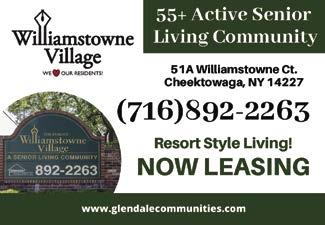
• In-unit Laundry • Walk-in shower w/ grab bars • Scheduled activities • Emergency pull cords • Free van service for shopping & trips
(716) 242-8888

DRIVE THE GREAT LAKES SEAWAY TRAIL

BY CHRISTINE A. SMYCZYNSKI
Thirty Mile Point Lighthouse at Golden Hill State Park overlooks Lake Ontario
Photo by Nick Vitello
Traveling long distances in these uncertain times can be challenging. Fortunately, our region boasts many beautiful places that are perfect for scenic drives and day trips. To see charming towns with picturesque venues, check out parts of the Great Lakes Seaway Trail (seawaytrail.com), a 518-mile scenic byway that extends from Western Pennsylvania along Lake Erie, then to the Niagara River, Lake Ontario, and up the St. Lawrence River.
Here we explore the portion from the Niagara River in Youngstown to Chimney Bluffs, just past the Rochester area. Drive time without stopping would be about two and a half hours one way; if you make several stops allow more time or turn this drive into several day trips. Before heading out, double-check that places are open and their current hours of operation.
Start your journey along Lake Ontario at Fort Niagara State Park in Youngstown, where you can visit Old Fort Niagara (oldfortniagara. org), a National Historic Landmark preserved as it stood in the eighteenth century. Allow several hours if you decide to visit the Fort. The journey continues along Route 18 toward Wilson where you’ll find Wilson-Tuscarora State Park, a 400 acre park with picnic areas, hiking trails, and a beach. Then check out views of Lake Ontario and the harbor from the nearby Wilson Pier.
Your next stop along the trail is the quaint community of Olcott Beach; many boutique gift shops—quirky to elegant—line the boardwalk along the Lake Ontario Shore in Lakeside Village Fair and are open daily. If you enjoy wine, be sure to stop at Marjim Manor (marjimmanor.com) a charming winery located in an 1853 mansion just east of Olcott on Route 18. Nearby, you can sample a variety of ciders at BlackBird Ciderworks (blackbirdciders.com), on Lower Lake Road in Barker. (To get there head north on Hartland Road from Route 18.)
Another state park along the way is Golden Hill State Park, home to the 1875 Thirty Mile Point Lighthouse, which is open for
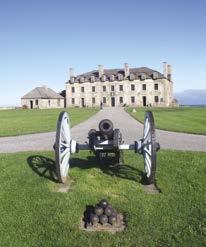
small group tours on weekends. As you continue east, you’ll come across the Lyndonville “Shoe Tree” (Lakeshore and Foss Roads), where hundreds of shoes are hung from its branches. According to legend, if you make a wish while throwing a pair of shoes up into the tree and they catch, your wish will come true.
Once you pass Lakeside Beach State Park, start looking for signs for Lake Ontario State Parkway, a thirtyfive-mile scenic parkway that follows Lake Ontario through Orleans and Monroe Counties. exit the parkway at Route 98 and head north to Point Breeze to see a replica of an earlier lighthouse built here.
Continuing east on the parkway, you’ll find Braddock Bay Wildlife Management area, a popular place to view waterfowl. The next mustsee attraction is Ontario Beach Park, which is said to have the best natural sand beach in the Great Lakes region. The park has a very long fishing pier to stroll on and a 1905 Dentzel carousel. Nearby, the Charlotte Genesee Lighthouse overlooks the Genesee River and the Port of Rochester. Built in 1821, it is the second oldest lighthouse in the region. They hope to be open for tours this summer; check their website for current information (geneseelighthouse.org).
Cross over the Genesee River on the Stutson Bridge to get to Lakeshore Boulevard and drive through Durand Eastman Park. Soon you will be at Culver Road and Seabreeze Amusement Park, the fourth oldest amusement park in the country. Check their website (seabreeze.com) for operating hours.
Continuing east, cross Irondequoit Bay on Route 104, to Bay Road to Lake Road to continue your drive along the lake. When you get to the village of Sodus Point, check out the view of the lake from the grounds of the Sodus Bay Lighthouse Museum. Unfortunately, the museum is closed for the season due to the pandemic but put it on your bucket list.
The final attraction on this drive is Chimney Bluffs State Park in Wolcott (from Sodus Point take Route 14 south to Ridge Road; head east to Lake Bluff Road, then head north on Lake Bluff Road to the park). The centerpiece of this park is the massive bluffs along the lake. There are several hiking trails through the park and one along the bluffs, which is right on the edge of a steep cliff, so use extreme caution when hiking this trail. There is an additional trail along the lakeshore at the base of the bluffs. FY
Christine Smyczynski is the author of Explorers Guide Buffalo Niagara Falls and Backroads & Byways of Upstate New York.
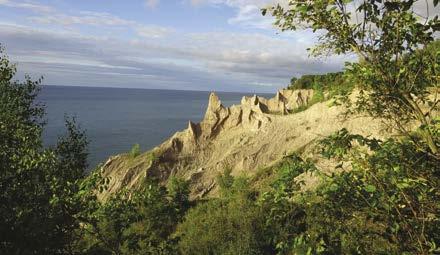
DISCOVER MORE
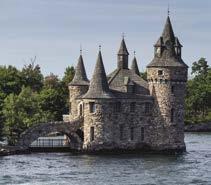
Boldt Castle
On the western end of the trail, Presque Isle State Park, in Erie, Pennsylvania, about ninety miles from Buffalo, has eleven beaches on a seven-mile-long peninsula, along with hiking and biking trails.
In Western Pennsylvania and Chautauqua County New York, you can visit numerous wineries in Lake Erie Wine Country (lakeeriewinecountry.org) on this fifty-mile wine trail.
The eastern portion of the Great Lakes Seaway Trail goes through the Thousand Islands region. Attractions include the Antique Boating Museum in Clayton, New York (abm.org), with boats displayed in over 29,000 feet of exhibit space.
Boldt Castle (boldtcastle.com) on Heart Island in Alexandria Bay was built in the early 1900s by millionaire George Boldt. It is open for tours. A short distance away, Singer Castle, on Dark Island, is also open for tours and has a royal suite that can be booked for overnight accommodations (singercastle.com).
In Massena, New York, visitors to the Eisenhower Locks can watch freighters as they go through the locks on the Saint Lawrence Seaway.
For more information on the Great Lakes Seaway Trail, visit seawaytrail.com.
A CELEBRATION OF THRIFTING
When shopping becomes philanthropy
BY DEREK SMITH
The pandemic, our federal government’s response, the current economy calamity, and mass demonstrations in response to racial injustice may have woken us from civic slumber. Unfortunately, the mere mention of civic duty conjures lessons from dusty textbooks about the monotony required to keep our democracy intact. What if there’s a way to contribute to the greater good without the tedium and messy sacrifice?
It’s heartening to know that you rummages for the perfect worn- Delaware, one in West Seneca, and can support veterans, donate to in jacket. A scraggly, bearded another in Depew. Buffalo boasts charity, reduce poverty, and save man, down on his luck, searches two Salvation Army locations; the earth even while gratifying an for a winter coat before the snow there are two more in Amherst and insatiable lust for consumption. begins to fly. A mom with kids is not Williamsville, respectively. Savers— Just go thrifting—and not at pricy, ashamed to be school shopping. slightly more selective—has spots trendy “vintage boutiques,” but at A curious fellow flips through the on Eggert Road in Tonawanda cold, gritty “Salvos” (Salvation Army books. This is an Amvets, Goodwill, and next to the McKinley Mall in stores) and Goodwills. Salvation Army, or Savers. Hamburg.
You know the type. Step into the At least one of each sits along These stores are like treasure warehouse and hear the echo of a main thoroughfare in the city chests sunken beneath the sea of metal hangers screeching across of Buffalo and most surrounding cheap, mass-market retail. If you’re clothing racks. A stuffy, musty suburbs. A Google Maps search in the mood to dig, you’ll never leave odor hangs in the air. And the returns two Goodwills in Buffalo, without getting something special stores always pipe in seventies and and one in each of these towns and in return for a modest expenditure. eighties music to hum along with villages: West Seneca, Hamburg, The wily, scrupulous thrifter might while shopping. Williamsville, Orchard Park, furnish a house, stock a handsome
An elderly woman nudges her Cheektowaga, and Tonawanda. wardrobe, and pass for an eclectic cart full of glassware and trinkets There’s an Amvets tucked behind snob. along the wall. An eccentric hipster a Valu Home Center in a plaza on Like all worthy things in life,

There are always treasures to be found in thrift stores, if you’re willing to take
the time to explore. Photos by kc kratt
thrifting is not so much about the end result as it is about the climb, the process, the journey. The thrill of the hunt, as it were. Shuffling through old clothing and inspecting bizarre appliances is enough of a pleasant sensory activity that it almost doesn’t matter if you leave with something you’ll actually use.
The classic literature, dictionaries, and Bibles that allegedly form the basis of human understanding go for $2 a pop. How democratic that those tomes are sold alongside dozens of “self-help” books for the same price. This inclusivity and paradox are what makes thrifting such an adventure. You might find a valuable antique in the same heap as the rubber largemouth bass wall mount that sings “Thank God
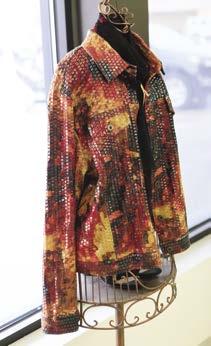


I’m a Country Boy.” As I write this, my keister is planted in a recliner I purchased from the West Seneca Amvets that only set me back $20, after “rounding up to support the vets” at the cashiers’ suggestion. You’ll feel like a sucker when you discover the blender doesn’t work and a thief when you discover an unblemished pair of shoes for eight dollars that retail for two hundred.
Having found ourselves at the receiving end of a year-long barrage of some pretty dismal news, we could be forgiven for letting the impending climate catastrophe slip our minds. Besides the financial benefit of buying secondhand goods during the worst financial crisis since the Great Depression, thrifting is good for the earth.
The fast fashion industry is an environmental abomination. In practice, it is little more than a racket designed to fatten CEOs and marketing men to the destruction of our natural world and the couple threads of individuality that remain after a few generations of crazed consumerism. Alas! Clothes from places like H&M, Old Navy, and Forever 21 are designed, constructed, and advertised precisely to fall out of fashion or disintegrate by the next season, whichever comes first.
When you buy secondhand, you’re recycling every item you take a chance on. When you decide you don’t like it, you bring it back in a trash bag full of outgrown jeans. You’ve recycled again.
Clothing that was union-made in the USA with natural materials like cotton, wool, or denim is built to last forever and gets better with each wear. You don’t find that stuff at the mall or (god forbid) Amazon. Thrift stores are filled with such garments for the same or less than you’d spend on some synthetic blend rag that a teenager glued together in a developing country in the thirteenth hour of his shift.
Readers of Buffalo Spree know about the deep, interwoven communal implications of consumerism. When you buy a burger from a local restaurant you read about here, even if you spend a few extra dollars, that money is going to support people who live and work in Western New York.
The same goes for consignment goods. Shopping at a local thrift store is an act of civic prudence. Amvets, Salvation Army, and Goodwill are all classified as 501(c)3 charities who do good work in the communities that they serve.
Unemployment rates in the region and the country are the highest they’ve been in a generation. Goodwill’s mission is to “prepare for, find, and keep jobs in Western New York for people with barriers to employment.” The first block of text under the “About Us” tab on the Salvation Army’s website reads, “We meet human need without discrimination.” Doesn’t get more straightforward than that. And of course, we can never do enough to support veterans, and Amvets is a leader in that endeavor.
Turns out our collective, earnest engagement in the dull business of public affairs—or lack thereof—has life or death consequences. The past year of bedlam has made painfully obvious what we can and must do to preserve this fragile democracy and improve the lives of our fellow countrymen: stand against bigotry, vote, wear a mask, and be a good citizen. While those can by turns feel inconvenient, boring, or downright difficult, thrifting is anything but. FY
Derek Smith is contributing writer for several Western New York and Erie County publications.
The “Senior Living Options” section of the 2021 Forever Young Senior Directory includes Apartments, Memory Care, Assisted Living, Nursing Homes/Skilled Nursing and Retirement Communities - all options related to long-term living. The list is sorted alphabetically by name, with the category or categories listed after the name, address and contact information. Should you find any information that needs to be corrected, please let us know - you can write to us at foreveryoungdirectory@buffalospree.com.
ABSOLUT CARE
(800) 888-9918 Absolut Care is a family of senior living communities located throughout Upstate New York. Our residents and their families trust us with their care and it’s a responsibility we don’t take lightly. If you or your loved one is looking for short-term rehab, long-term care, skilled nursing or outpatient therapy, we can make life a lot easier.
See our ad on page 36.
ABSOLUT CARE OF ALLEGANY
2178 North Fifth Street Allegany, NY 14706 373-2238, absolutcare.com • Nursing Homes/Skilled Nursing,
Rehabilitation and Recovery Care
ABSOLUT CARE OF AURORA PARK
292 Main Street East Aurora, NY 14052 652-1560, absolutcare.com • Memory Care, Nursing Homes/
Skilled Nursing, Rehabilitation and Recovery Care
ABSOLUT CARE OF GASPORT
4540 Lincoln Drive Gasport, NY 14067 772-2631, absolutcare.com • Nursing Homes/Skilled Nursing,
Rehabilitation and Recovery Care
ABSOLUT CARE OF ORCHARD BROOKE
6060 Armor Duells Road Orchard Park, NY 14127 662-6753, absolutcare.com • Assisted Living
ABSOLUT CARE OF THREE RIVERS ABSOLUT CARE OF WESTFIELD
26 Cass Street Westfield, NY 14787 326-4646, absolutcare.com • Nursing Homes/Skilled Nursing, Rehabilitation and Recovery Care
ACADEMY PLACE APARTMENTS - PEOPLE INC.
1 School Street Gowanda, NY 14070 817-9090, people-inc.org •Apartments
ANGLE PARK SENIOR COMPLEX
2766 Angle Road Orchard Park, NY 14127 675-2777, maryvaleeast.com • Apartments
AMBERLEIGH
2330 Maple Road Williamsville, NY 14221 (877) 689-3262, amberleigh.net • Retirement Communities
See our ad on page 17.
ASBURY POINTE RETIREMENT COMMUNITY
An affiliate of Beechwood Continuing Care 50 Stahl Road Getzville, NY 14068; 810-7500 beechwoodcare.org/asbury.html • Retirement Communities
AUSTIN MANOR APARTMENTS
395 Tonawanda Street Buffalo, NY 14207; 874-1572 • Apartments
AUTUMN VIEW HEALTH CARE FACILITY
4650 Southwestern Boulevard Hamburg, NY 14075 648-2450, mcguiregroup.com • Nursing Homes/Skilled Nursing,
Rehabilitation and Recovery
Care, Respite Care
BAPTIST MANOR APARTMENTS
276 Linwood Avenue Buffalo, NY 14209 881-1120, baptist-manor.org • Apartments
BEECHWOOD CONTINUING CARE
2235 Millersport Highway Getzville, NY 14068 810-7370, beechwoodcare.org Beechwood Continuing Care is a not-for-profit senior care community providing various levels of care, including independent living, assisted and enhanced living, short-term rehabilitation, person centered skilled nursing and hospice care. Beechwood was the first senior community to introduce personcentered care and households in a skilled nursing community… we call it “Welcome Home.” • Apartments, Assisted Living,
Memory Care, Nursing
Homes/Skilled Nursing,
Rehabilitation and Recovery
Care, Respite Care,
Retirement Communities.
See our ad on page 47.
BEECHWOOD HOMES
An affiliate of Beechwood Continuing Care 2235 Millersport Highway Getzville, NY 14068 810-7000, beechwoodcare.org/ bw_homes_a.html • Hospice Household, Memory
Care, Nursing Homes/
Skilled Nursing; Rehabilitation and Respite Care
BELL TOWER SENIOR APARTMENTS
42 Haley Lane Cheektowaga, NY 14227 656-7262, belltowerapts.com • Apartments



